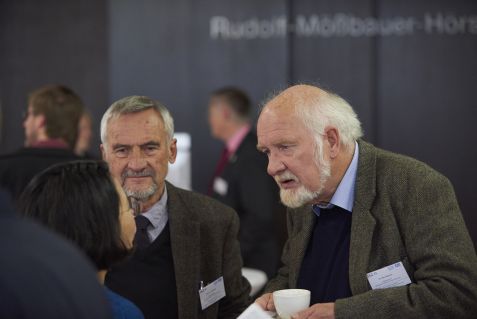MLZ is a cooperation between:
 > Technische Universität München
> Technische Universität München > Helmholtz-Zentrum Hereon
> Helmholtz-Zentrum Hereon
 > Forschungszentrum Jülich
> Forschungszentrum Jülich
MLZ is a member of:
 > LENS
> LENS > ERF-AISBL
> ERF-AISBL
MLZ on social media:

MLZ (eng)
Lichtenbergstr.1
85748 Garching
Remembering Dr. Hans Boysen
28.04.2021

Dr. Hans Boysen (r.) in 2018 on the occasion of a celebratory colloquium in conversation with colleagues of his Chair of Crystallography, Prof. Dr. Sohyun Park (l.) and Prof. Dr. Friedrich Frey. © Wenzel Schürmann/ Technische Universität München
He knew the Atomic Egg when it was still in its early stages and showed great commitment to the FRM II research neutron source: On March 19, 2021, Dr. Hans Boysen died at the age of 76.
Born in 1944 in Karlsbad, Dr. Hans Boysen attended school in Flintbek and Kiel, where he later also began his physics studies. After his intermediate diploma, he was drawn to Bavaria, to the Ludwig Maximilian University in Munich. Following his physics diploma, he completed his doctorate there at the Institute of Crystallography and Mineralogy together with Prof. Friedrich Frey, who was to become his companion for over 35 years and more than 50 publications.
Great commitment to the Atomic Egg and FRM II
Already at the research reactor FRM, the so-called Atomic Egg, as well as later at the Research Neutron Source Heinz Maier-Leibnitz (FRM II), Hans Boysen had a major impact on the research. He was particularly involved in the planning, construction, and utilization of the powder diffractometer SPODI at FRM II. He was also involved in an advisory capacity in the conception of the single crystal diffractometer RESI. In addition, his methodological work contributed to the development of focusing monochromators and special sample environments, for example with measurements at very high temperatures up to more than 2000 °C.
Hans Boysen’s involvement went far beyond FRM II. Because of his broad expertise, he was active in national and international committees. He also contributed intensively to teaching at LMU Munich, where he supervised numerous student research projects, diploma theses, and doctoral dissertations.
“I greatly appreciated Hans Boysen because of his calm and sympathetic manner,” said Dr. Martin Meven, instrument scientist at the Heinz Maier-Leibnitz Center’s hot single-crystal diffractometer HEiDi. A sentiment shared by many other colleagues.
Boysen’s research brought order into disorder
Boysen’s scientific work focused on investigations, using X-ray and neutron diffraction, of phenomena arising from disorder in materials. This includes, for example, the characterization of oxygen and lithium ion conductors. “His work together with the evaluation methods presented in the process are of high current interest in the field of energy storage and transport,” emphasizes Dr. Markus Hölzel, scientist at the SPODI instrument and colleague of Hans Boysen.
For his outstanding achievements in the development of scattering methods for structural research and in the field of disorder crystallography, Dr. Hans Boysen, together with his long-time colleague Prof. Friedrich Frey, received the Will-Kleber commemorative coin of the German Society for Crystallography in 2010.
MLZ is a cooperation between:
 > Technische Universität München
> Technische Universität München > Helmholtz-Zentrum Hereon
> Helmholtz-Zentrum Hereon
 > Forschungszentrum Jülich
> Forschungszentrum Jülich
MLZ is a member of:
 > LENS
> LENS > ERF-AISBL
> ERF-AISBL
MLZ on social media:


